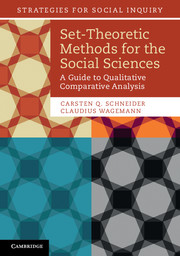Book contents
- Frontmatter
- Contents
- Figures
- Tables
- Acknowledgements
- Introduction
- Part I Set-theoretic methods: the basics
- Part II Neat formal logic meets noisy social science data
- Part III Potential pitfalls and suggestions for solutions
- 8 Potential pitfalls in the Standard Analysis procedure and suggestions for improvement
- 9 Potential pitfalls in the analysis of necessity and sufficiency and suggestions for avoiding them
- Part IV Variants of QCA as a technique meet QCA as an approach
- Glossary
- Bibliography
- Index
9 - Potential pitfalls in the analysis of necessity and sufficiency and suggestions for avoiding them
Published online by Cambridge University Press: 05 November 2012
- Frontmatter
- Contents
- Figures
- Tables
- Acknowledgements
- Introduction
- Part I Set-theoretic methods: the basics
- Part II Neat formal logic meets noisy social science data
- Part III Potential pitfalls and suggestions for solutions
- 8 Potential pitfalls in the Standard Analysis procedure and suggestions for improvement
- 9 Potential pitfalls in the analysis of necessity and sufficiency and suggestions for avoiding them
- Part IV Variants of QCA as a technique meet QCA as an approach
- Glossary
- Bibliography
- Index
Summary
Pitfalls in inferring necessity from suffi ciency solution terms
h ere are two pitfalls related to the analysis of necessity: the disappearance oftrue necessary conditions and the appearance of false necessary conditions .We illustrate both fallacies using data from published QCA. As before in thebook, we do not aim at reanalyzing the original studies but rather alter themin order to better demonstrate our methodological arguments.
Hidden necessary conditions
Hidden necessary conditions can occur due to two, mutually non-exclusivefeatures of the data at hand. One reason consists in the kind of assumptionsmade on logical remainders. The other reason rests in the treatment of less-than-perfect set relations. In the following, we provide one example for eachsource. From these examples, we then derive the general conditions underwhich this phenomenon occurs.
Hidden necessary conditions due to incoherent counterfactuals
Stokke (2004) aims at identifying the conditions under which the strategy ofshaming makes hitherto non-compliant countries observe international fishingrules (SUCCESS). He identifies five conditions: advice (A); commitment (C); shadow of the future (S); inconvenience (I); and reverberation (R). h eten countries evenly split into five successful and five unsuccessful incidencesof shaming. The cases fall into eight different truth table rows (four connectedto success and four to the lack of success). Given a truth table with 25 conditions,there are 32 − 8 = 24 logical remainders (Table 9.1).
Information
- Type
- Chapter
- Information
- Set-Theoretic Methods for the Social SciencesA Guide to Qualitative Comparative Analysis, pp. 220 - 250Publisher: Cambridge University PressPrint publication year: 2012
Accessibility standard: Unknown
- 3
- Cited by
